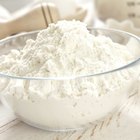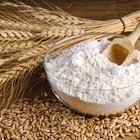
Coconut flour is made from grinding the bits of solid coconut meat leftover after pressing the milk out of the coconut into a fine powder. The gluten-free flour is rich in fiber and protein. When making scones with coconut flour, you must consider the views of two differing baking camps. Some bakers are of the opinion you can never replace 100 percent of the flour in a recipe with coconut flour, while others believe you can. A look at the reasoning behind each argument will help you to modify your scone recipes to suit your taste.
Supporting Character
Proponents of a partial replacement method suggest that only 10 to 30 percent of a scone's flour should be replaced with coconut flour. Coconut flour has a different texture from other flours and absorbs far more moisture than a wheat flour, such as all-purpose flour. Additionally, it lacks the gluten of wheat-based flour, so during baking it becomes more dense. An option for creating a gluten-free scone is to use 30 percent coconut flour and 70 percent almond flour, along with about 1/2 teaspoon additional baking soda or baking powder. You will likely also need to add more liquid and should increase the milk, egg or water.
Star of the Show
Proponents of a 1-to-1 substitution of coconut flour for wheat flours suggest careful attention to altering the other ingredients of the original recipe will help to account for the difference texture and characteristics of the coconut flour. When making scones with 100 percent coconut flour, add an extra egg for every 1 ounce of flour. The egg serves two primary purposes: to add moisture and to provide the lift that is missing due to the lack of gluten in the flour. Eggs, when whipped into a recipe, trap air and serve as leavening agents. They also act as binders, to provide structure for the scone in the absence of gluten.
Maintaining Moisture
Although scones often are drier than other baked goods, because coconut flour absorbs significantly more moisture than its wheat-based counterparts, you must be careful to maintain appropriate moistness in your scone batter. Adding extra eggs is a simple way both to moisten and build up structure, but this is not your only option. Instead of using granulated sugar, you can replace the dry sugar with a liquid sweetener, such as honey, agave nectar or simple syrup. Alternatively, you can increase the amount of water, milk, or buttermilk in the recipe, or simply add the ingredient. Coconut milk works well to this end. You are not limited to one technique, though, and can add an extra egg or two plus extra liquid. Experiment until you get your perfect scones.
Advantages and Disadvantages
The primary advantage to baking scones with coconut flour is for those who cannot digest gluten or for those trying to increase fiber intake. The unsaturated fats and protein in the flour are filling, which may make you eat less later. Coconut flour has some disadvantages, which primarily affect the way you mix your recipe. Not only must you account for the extra absorption of moisture by the coconut flour, you also must be careful to thoroughly mix the scone batter, as coconut flour tends to clump. This can be a tricky balance to strike, as over-mixing the batter may make the scones tough. Additionally, scones made with coconut flour tend to be more dense than traditional scones. You can counteract this to a degree by adding leavening agents, such as eggs or baking soda, but the texture may still be different than a classic scone.
Related Articles

Can I Make Boxed Devil's Food Cake Mix ...
Baking With Almond, Rice & Coconut Flour

Does Adding an Extra Egg to Brownie Mix ...

Applesauce as an Egg Substitute for ...

What Can You Use in Place of Egg Yolk ...

How Much Applesauce Do You Substitute ...

Can I Substitute Bleached for ...
What Is the Difference Between Cake ...

What Can I Use as an Egg Substitute ...

How to Use Millet Flour

How to Cook With Coconut Flour for Main ...
Role of Xanthan Gum in Vegan Baking

How to Use Oat Flour in a Pie Crust
Flour Substitute for Muffins

Do Eggs Make Baked Goods Rise?

Differences Between Bleached Flour & ...

A Heavy Cream Substitute for Creme ...
What Is the Purpose of Cream of Tartar ...

What Is a Substitute for Potassium ...
Cooking With Wheat Vs. White Flour
References
- On Food and Cooking: The Science and Lore of the Kitchen; Harold McGee
- Baking and Pastry: Mastering the Art and Craft; The Culinary Institute of America
- Nourished Kitchen: How to Bake with Coconut Flour: Tips and Tricks for Using this Gluten-free Flour
Resources
Writer Bio
Kathryn Roberts has worked in the culinary industry for nearly a decade in various roles, including pastry chef and bakery manager. After studying at the Culinary Institute of America, she earned her BFA from Goddard College and is pursing an MFA in Writing from Vermont College of Fine Arts.
Photo Credits
Jupiterimages/Photos.com/Getty Images